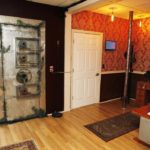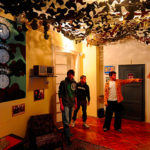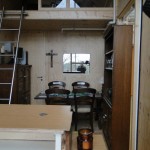Last week while I was on a short spring break trip with the kids (photos to follow!), I was perusing the International Building Code (IBC), and I found a change that I forgot to write about; the change is related to escape rooms. These are businesses where groups of friends, family members, coworkers, etc. work together to solve a puzzle in a certain amount of time, so they can “escape” from the room. There are several past posts on iDigHardware about escape rooms, including a WWYD? post asking for your insight, and a post about a fire in an escape room facility where 5 teenagers were killed.
I went to an escape room last year, and of course I took note of the doors. In that particular facility, there was free egress available at all times – we were never “locked in.” We followed the clues to move from one area to the next, but we could always backtrack and leave the way we entered. Because it was a business occupancy with a low occupant load, and the exit was not disguised and did not require special knowledge or effort for egress, the single exit was code-compliant.
Unfortunately, this is not the case with all escape rooms. When these businesses first became popular, there were no prescriptive requirements in the model codes, so code officials were responsible for deciding what to allow – if they were even consulted during design and construction. In some escape rooms, participants were actually locked in the room until they solved the puzzle or were released by a timer, an employee, or possibly fire alarm activation.
Prescriptive requirements were added to the 2021 edition of the IBC, which will help to ensure a more consistent approach to the egress in these facilities. In the IBC, these rooms are called puzzle rooms, and are defined this way: A puzzle room is a type of special amusement area in which occupants are encouraged to solve a challenge to escape from a room or series of rooms.
The new requirements are found in Section 411 of the 2021 edition, which covers special amusement areas. There are three options for puzzle room exiting that are included in the 2021 IBC:
- The exit can comply with the requirements of Chapter 10 – Means of Egress, or
- An alternative design can be approved by the building official, or
- The exit must be open and readily available upon activation of the fire alarm, sprinkler system, and by manual control at a constantly attended location.
I’m generally not a fan of egress doors that are locked until the fire alarm or sprinkler system is activated, or doors that are controlled by a person who can allow or prohibit egress, BUT…that is one of the options allowed by the 2021 IBC (#3). At least this means that the building will have a fire alarm / sprinkler system, in addition to the employee monitoring the rooms. The IBC Commentary notes that this section was added to provide safe exiting requirements in an emergency while maintaining the appeal of exit routes that are disguised or hidden. The Commentary also clarifies that the intent of Item 3 is that if the exit is disguised or hidden, it must be easily identified and accessed when the fire alarm is activated. I would recommend consulting the Authority Having Jurisdiction to confirm that the egress plan is acceptable, especially because these rooms change fairly frequently.
Questions? Comments? Concerns?
You need to login or register to bookmark/favorite this content.











Lori…… You take the IBC and “Peruse” it while on a Spring Break Trip….. That sounds like Hermione with a huge book and doing some light reading, in Harry Potter!!! Now we know that magazine was confirming what we already knew!! Nice Job Girl!!
Yeah, I’m a weirdo. 🙂
– Lori
Item 3 would make a little more code sense if the “or” was removed and replaced with a comma thus requiring all three conditions.
Also noteworthy is a lack of limitation in terms of how many of these rooms may be in one facility or how large of a space or “rooms” may be “monitored” by only one person. In other words how long would it take to safely clear all of the rooms and what happens if staff just evacuates or can’t release all of the rooms / account for all of the patrons?
I was in a facility recently that offered food, beverage, puzzle rooms, and axe throwing with the only person on duty being a high school student. I did wonder a bit about how long they may have worked there, what type of training they may have received, and their “sense of duty” should an emergency situation develop. More worrisome was the question of interior finish and the appropriateness of the products applied to the walls and ceilings to create the ambiance.
The codes could and should do more. Unfortunately due to the snail pace at which codes are updated and adopted, the current fad of going to a puzzle room will likely have long passed before the codes figure this out.
Hi Larry –
The code is actually written as you suggested, but I’m not sure if both a fire alarm and a sprinkler system would be required for these buildings. Here is the exact wording: Exits shall be open and readily available upon activation by the automatic fire alarm system, automatic sprinkler system, and a manual control at a constantly attended location. I was thinking about the facility size and the staff training as well, and I agree that by the time the codes include all of the necessary language for puzzle rooms, their appeal will likely have faded.
– Lori